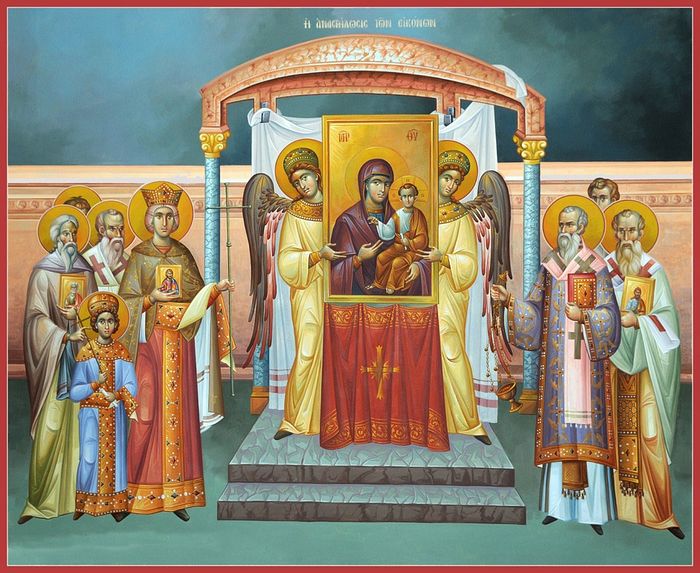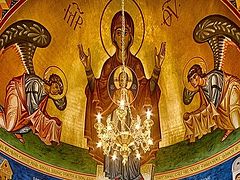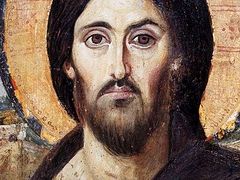Source: The Ukrainian Orthodox Church of the USA
March 15, 2016
The liturgical celebration of the First Sunday of the Great Fast, like all the other Sundays of the Great Fast, has gone through an evolution over the course of time. Originally it was a commemoration of the Old Testament prophets and their prophesies concerning our Lord based on the Gospel account wherein Philip tells Nathaniel, "We have found the one about whom Moses wrote in the Law, and also the prophets,” (John 1:45). The Apostolic Reading from Hebrews also speaks about the prophets and their sufferings and concludes, “therefore, since we for our part are surrounded by this cloud of witnesses, let us lay aside every encumbrance of sin which clings to us and persevere in running the race which lies ahead; let us keep our eyes fixed on Jesus, the leader and perfecter of faith.” (Hebrews 12:1-2) Additionally the Alleluia verses also uphold this theme: Moses and Aaron were among His priests, and Samuel among those who called upon His Name. They called upon the Lord, and He answered them. (Psalm 98:6)
The major emphasis of this Sunday now is the Triumph of Orthodoxy, a triumph that is not only about the restoration of the Holy Icons, but the final defense against centuries-long struggle to correctly define the revealed teachings about the Incarnation of the Only-Begotten Son of God. The defense of the Holy Images was not a struggle over art, but of the reality of the Incarnation of the Son of God. The teaching of the Church is not that it is permissible to have Christ, the Birthgiver-of-God and saints depicted in images, but rather that it is essential that Orthodox believers do so. It is not an option, but an obligation. Failure to do so reflects an incomplete understanding and acceptance of the Incarnation, that the Son and Word of God became fully human. Because this theme is also reiterated by the Church every October on the Sunday that falls between October 11-17 when we commemorate the Holy Fathers of the Seventh Ecumenical Council, I think it is more important to concentrate on the original theme of this First Sunday of the Great Fast which still is present, even if subliminally, in the designated Readings for the Sunday.
So, stripped of all the pageantry of icon processions and proclamations of our Orthodoxy faithfulness and unity in the faith if not in outward manifestation, what was the original message of the Church on this first Sunday of the Great Fast for fasting Orthodox Christians? Apparently, a rather straight-forward message that we are called to be followers of Christ. Just as Philip, Nathaniel and all the early disciples of Christ “obtained what had been promised as part of God’s better plan, a plan which included us” (Hebrews 11:39-40), so everything that has been perfected throughout the ages has been perfected through the death and resurrection of Jesus Christ. The perfection we seek as Christians is like the Old Testament patriarchs and prophets who preceded us preparing the way for us. It is like the holy martyrs, fathers and mothers of the Church who were perfected by suffering and surrendering of themselves to our Lord, God and Savior Jesus Christ. We are part of the Divine Plan which unites us to all the holy and righteous ones who have preceded us. In being the fulfillment of the promises, Jesus Christ enables us to the perceive the opened heavens ascending and descending on the Him like the heavenly angels. (John 1:51). This ladder is an allusion to an episode recounted in the Book of Genesis in which the Old Testament Patriarch Jacob saw the sky opened and the angels of God ascending and descending on it. (28:12).
Our Lenten struggles are undertaken with the idea that we are in a cataclysmic struggle with Evil and the evil inclinations within each and every one of us. Yet, just as the fulfillment of all the Law and the Prophets can come from an insignificant place like Nazareth, so we can encounter God in even the most mundane of places through this ascetic struggle. Jacob encountered God in a desolate place at an unexpected time. Often that is where we encounter God. The Ointment-Bearing Women encountered the Risen Christ in the mundane task of going to His grave to anoint His Body. The struggle is not a one-time event, but rather a life-l9ong challenge. A person who is convinced he or she is already saved is suffering from a dangerous delusion. Our Lord Himself in His human weakness encountered and overcame sinful inclinations even on the Cross itself. How can we expect our struggle to be any less?
So how does this fit in with the Holy Images? The Church maintained the fundamental teaching of the Church expressed through the appointed readings because the relationship of the spiritual struggle with the Holy Images is an obvious one: Just as we were made in the image and likeness of God, our Lenten struggles are our attempt to cooperate with the grace of God to restore that likeness which was distorted by sin. We can aspire to that which is heavenly because the Infinite One has borne our lowliness and enables us to descend and ascend to and from the heavens on Him. The angel who wrestled with the Patriarch Jacob told Jacob his name was now Israel which means “One who struggles or contends with God.” Orthodox Christians do not contend with God, but our sinful inclinations often put us at odds with Him when trying to accept the Divine Plan and God’s Will which, more often than not, does not coincide with our personal agenda. Our struggle is discerning faithfully God’s Will in our lives, and being faithful to it.
May our Good and Gracious God continue to grace us through our Lenten struggle. We struggle not with angels, but with the inner demons which continually strive to subdue our souls lead us astray.



